The White-tailed Tropicbird (Phaethon lepturus) is a striking seabird renowned for its graceful flight and distinctively long, white tail feathers.
Found in tropical and subtropical regions across the world, this avian species is captivating with its elegant appearance and fascinating behaviors.
With a slender body, long wings, and sharply pointed yellow bill, the White-tailed Tropicbird is well-adapted for a pelagic lifestyle, spending much of its time soaring effortlessly over the open ocean.
During the breeding season, these birds form monogamous pairs and nest on remote cliffs or rocky ledges, showcasing intricate courtship displays and remarkable parental care.
As an iconic species of marine ecosystems, understanding the White-tailed Tropicbird’s biology and ecology is vital for conserving its populations and preserving the delicate balance of coastal and oceanic habitats. Stay sharp.
Individualizing Criteria of White-tailed Tropicbird

The White-tailed Tropicbird (Phaethon lepturus) is a striking seabird known for its graceful flight and distinctive appearance.
Identifying this bird requires attention to detail and awareness of key characteristics. Here are some of the key points to help differentiate the White-tailed Tropicbird from other seabirds:
Body Size and Shape
The White-tailed Tropicbird is a medium-sized bird with a body length ranging from 71 to 79 centimeters (28 to 31 inches).
Its body is slender and streamlined, ideal for swift aerial movements. The wings are long and narrow, suited for soaring effortlessly over the ocean.
Coloration
One of the most striking features of the White-tailed Tropicbird is its predominantly white plumage.
The wings and back may have a slight wash of pale grey, but the overall impression is of a bird with brilliant white feathers. Its black markings are confined to its distinctive facial pattern and tail feathers.
Facial Markings
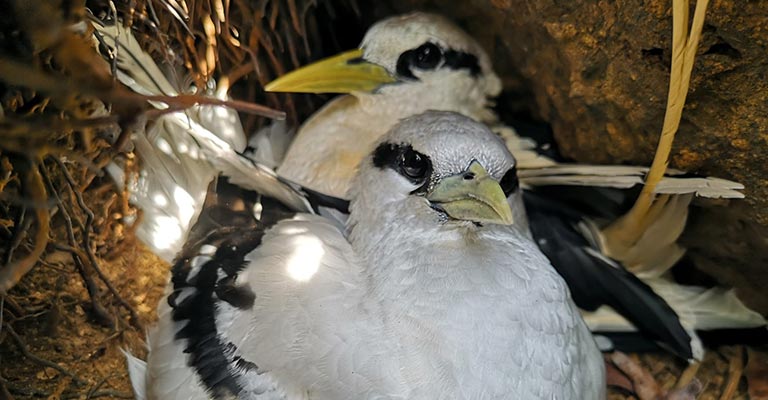
The face of the White-tailed Tropicbird is adorned with bold black markings.
This includes a dark patch around the eye, giving the appearance of a mask, and a black stripe extending from the eye to the nape of the neck. These markings stand out prominently against the bird’s white plumage.
Bill Shape
The bill of the White-tailed Tropicbird is long, slender, and sharply pointed. It is yellow in color, contrasting with the black markings on the face. The bill is adapted for catching small fish and squid, which form the bulk of the bird’s diet.
Tail Streamers
Perhaps the most distinctive feature of the White-tailed Tropicbird is its long, white-tail streamers.
These streamers can measure up to 35 centimeters (14 inches) in length, extending beyond the bird’s body during flight. The presence of these streamers is a key characteristic for identification.
Flight Pattern

When in flight, the White-tailed Tropicbird displays a graceful and buoyant flying style.
It often soars effortlessly on thermals, with wings held in a distinctive V-shape. The long tail streamers trail behind, adding to the bird’s elegant appearance.
Habitat and Range
White-tailed Tropicbirds are primarily pelagic, meaning they spend most of their lives at sea.
They are commonly found in tropical and subtropical waters around the world, particularly in the Indian and Pacific Oceans. They breed on remote islands and atolls, often nesting on cliffs or rocky ledges.
Behavior
While at sea, White-tailed Tropicbirds are solitary or found in small groups. They are agile flyers and adept at plunge-diving to catch prey.
During the breeding season, they form monogamous pairs and engage in elaborate courtship displays, including aerial acrobatics.
The White-tailed Tropicbird can be identified by its medium-sized, streamlined body, predominantly white plumage with bold black facial markings, long tail streamers, slender yellow bill, graceful flight pattern, pelagic habitat, and solitary or paired behavior.
These characteristics distinguish it from other seabird species and make it a truly captivating sight to behold in the open ocean.
Taxonomy of White-tailed Tropicbird

Below is the table detailing the taxonomy of the White-tailed Tropicbird:
| Taxonomic Rank | Classification |
| Domain | Eukaryota |
| Kingdom | Animalia |
| Phylum | Chordata |
| Class | Aves |
| Order | Phaethontiformes |
| Family | Phaethontidae |
| Genus | Phaethon |
| Species | P. lepturus |
The White-tailed Tropicbird (Phaethon lepturus) is a species distributed across various regions, with six recognized subspecies identified by the International Ornithological Congress (IOC). Here’s a brief overview of each subspecies:
- P. l. lepturus: This subspecies is found across the tropical Indian Ocean. It represents the typical White-tailed Tropicbird, characterized by its predominantly white plumage and long tail streamers.
- P. l. fulvus (Golden Bosun): Native to Christmas Island, this subspecies exhibits a unique golden wash to its white plumage, giving it a distinct appearance compared to other subspecies.
- P. l. dorotheae: Distributed in the tropical western Pacific, this subspecies shares many similarities with the typical White-tailed Tropicbird but may have subtle differences in plumage coloration or behavioral traits specific to its range.
- P. l. catesbyi: Found in Bermuda and the Caribbean, this subspecies may display variations in plumage coloration or slight differences in size compared to other subspecies.
- P. l. ascensionis: Inhabiting Ascension Island and Fernando de Noronha, this subspecies may have adapted to its unique island habitats, potentially exhibiting distinct behaviors or ecological preferences.
- P. l. europae: Located in Europa Island in the southern Mozambique Channel, this subspecies may have evolved in isolation, leading to potential differences in morphology or behavior compared to other populations.
While these subspecies share many common traits, including their pelagic lifestyle and elegant flight, studying their differences can provide valuable insights into the evolutionary history and ecological dynamics of the White-tailed Tropicbird across its diverse range.
Hunting Habit of White-tailed Tropicbird
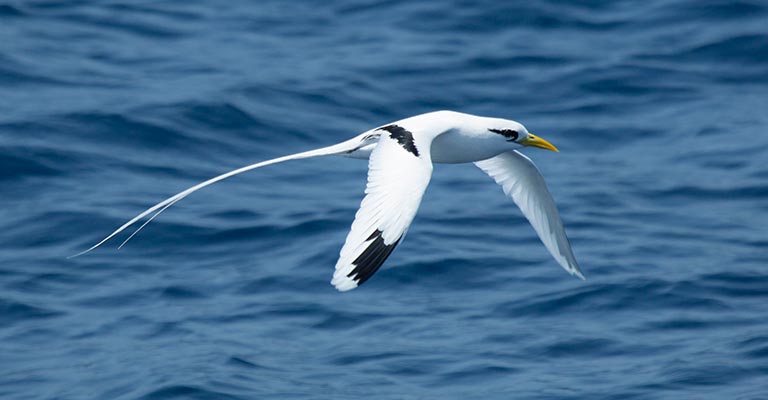
The White-tailed Tropicbird is an adept hunter, primarily targeting small fish and squid as its main prey. Using its keen eyesight, it searches for prey while soaring over the ocean, often flying low to the water’s surface.
When a suitable target is spotted, the bird performs agile aerial maneuvers, diving sharply toward the water with its long, slender body.
With precise timing and coordination, it extends its sharp bill to snatch the prey from the water’s surface.
The bird’s streamlined shape and rapid movements enable it to execute successful plunge-dives with ease. After catching its prey, the White-tailed Tropicbird may consume it in flight or return to a perch to feed.
This hunting strategy allows the bird to efficiently forage across expansive oceanic territories, making the most of its pelagic habitat.
White-tailed Tropicbird Life History
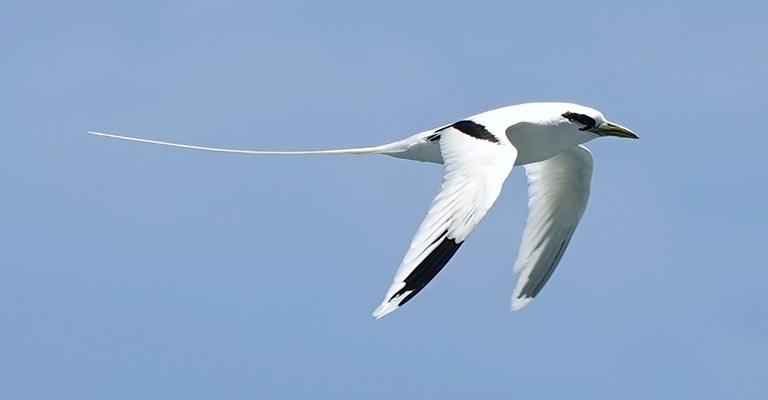
The White-tailed Tropicbird (Phaethon lepturus) is a captivating seabird known for its graceful flight and striking appearance. Understanding its life history provides insights into its ecological role and conservation needs.
Food
White-tailed Tropicbirds primarily feed on small fish and squid, which they catch by plunge-diving into the ocean.
Their long, slender bills and keen eyesight make them efficient hunters, allowing them to snatch prey from the water’s surface with precision.
Habitat
These seabirds inhabit tropical and subtropical waters worldwide, favoring remote islands and atolls for breeding and nesting. They spend much of their lives at sea, only coming ashore to breed and rear their young.
Range Map
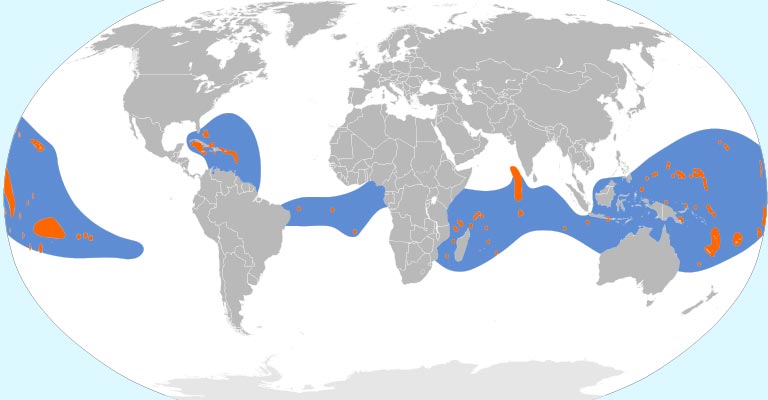
White-tailed Tropicbirds have a wide range across the Indian and Pacific Oceans, with breeding colonies found on islands and coastal cliffs. Their distribution is influenced by oceanic currents and suitable nesting sites.
Nesting
Nesting typically occurs on steep cliffs or rocky ledges, where the birds construct simple nests of grass, twigs, and debris. They may also nest in crevices or burrows to protect their eggs and chicks from predators.
Check out a table detailing the nesting characteristics of the White-tailed Tropicbird below:
| Nesting Details | Facts |
| Clutch Size | Vulnerable to predation by introduced mammals and birds; parents may defend nest vigorously. |
| Number of Broods | Typically 1 brood per breeding season |
| Egg Length | Approximately 6.5 to 8.0 centimeters |
| Egg Width | Approximately 4.5 to 5.5 centimeters |
| Incubation Period | Around 40 to 45 days |
| Nestling Period | Approximately 70 to 80 days |
| Egg Description | Glossy white with a slightly chalky texture |
| Nest Type | Simple scrape in soil or sand, or nestled in crevices or burrows |
| Nest Material | Sparse, made of grass, twigs, and debris |
| Nest Location | Often on steep cliffs, rocky ledges, or in protected burrows |
| Parental Care | Both parents share incubation and chick-rearing duties |
| Predation and Protection | Vulnerable to predation by introduced mammals and birds; parents may defend the nest vigorously. |
This table provides a comprehensive overview of the nesting habits of White-tailed Tropicbirds, including details about egg characteristics, nesting behavior, parental care, and potential threats to nesting success.
Breeding
White-tailed Tropicbirds form monogamous pairs during the breeding season, engaging in elaborate courtship displays characterized by aerial acrobatics and vocalizations.
Females lay a single egg, which both parents take turns incubating and caring for until it hatches.
Diseases
While White-tailed Tropicbirds face few natural predators, they may be susceptible to diseases transmitted by parasites or contaminated food sources. Common health concerns include avian pox and bacterial infections.
Treatment
Conservation efforts often include monitoring for signs of disease outbreaks and providing medical treatment to affected individuals.
This may involve administering antibiotics, antiparasitic medications, or supportive care to improve the bird’s health and reduce the spread of disease within populations.
Conservation
Despite their widespread distribution, White-tailed Tropicbirds face threats from habitat loss, predation by introduced species, and pollution.
Conservation measures such as habitat protection, invasive species control, and public education are essential for ensuring the long-term survival of these majestic seabirds.
The life history of the White-tailed Tropicbird reflects its adaptation to a pelagic lifestyle, emphasizing its reliance on healthy marine ecosystems and the need for conservation efforts to safeguard its future.
10 Fun Facts About /Behavioral Habits of White-tailed Tropicbird
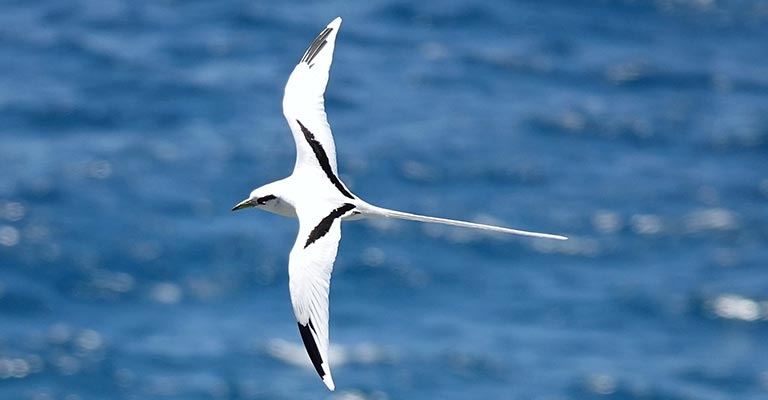
The White-tailed Tropicbird (Phaethon lepturus) is a fascinating seabird known for its elegant flight and striking appearance.
Beyond its physical attributes, the behavioral habits of this bird offer insight into its unique lifestyle and adaptations. Here are 10 fun facts about the behavioral habits of the White-tailed Tropicbird:
- Courtship Displays: During the breeding season, White-tailed Tropicbirds engage in elaborate courtship displays involving aerial acrobatics and vocalizations to attract mates.
- Monogamous Pairs: Once paired, White-tailed Tropicbirds form monogamous bonds for the breeding season, sharing nesting duties and caring for their offspring together.
- Precise Plunge-Diving: When hunting for prey, White-tailed Tropicbirds exhibit precise plunge-diving behavior, using their keen eyesight to spot prey from above and swiftly diving to catch it in mid-air.
- Territorial Defense: White-tailed Tropicbirds are territorial during the breeding season, vigorously defending their nesting sites from intruders, including other seabirds and potential predators.
- Vocalizations: These birds are not typically known for their vocalizations, but during the breeding season, they may produce various calls and chirps as part of courtship and territorial displays.
- Parental Care: Both male and female White-tailed Tropicbirds take turns incubating the egg and feeding the chick once it hatches, demonstrating remarkable parental care and cooperation.
- Long-Term Pair Bonds: While they may form new pair bonds each breeding season, White-tailed Tropicbirds often return to the same nesting sites and reunite with previous mates, indicating a degree of long-term pair bonding.
- Social Behavior: While primarily solitary at sea, White-tailed Tropicbirds may gather in small groups around feeding areas, providing opportunities for social interaction and potentially sharing information about food sources.
- Migration: Although they are largely sedentary, White-tailed Tropicbirds may undertake localized movements or dispersals outside of the breeding season in search of suitable foraging grounds.
- Adaptations for Flight: The White-tailed Tropicbird’s streamlined body, long wings, and deeply forked tail are all adaptations for its aerial lifestyle, enabling it to soar effortlessly over the open ocean and perform intricate flight maneuvers.
These fun facts highlight the fascinating behavioral habits and adaptations of the White-tailed Tropicbird, underscoring its importance as a unique and charismatic seabird species.
Wrapping Up
The White-tailed Tropicbird is a remarkable seabird with a distinctive appearance and fascinating behavioral habits.
From its graceful flight to its intricate courtship displays, this species captivates both researchers and bird enthusiasts alike.
Understanding its life history, nesting behavior, and unique adaptations is crucial for conservation efforts aimed at protecting this iconic bird and its marine habitats for future generations to appreciate. Thank you so much.